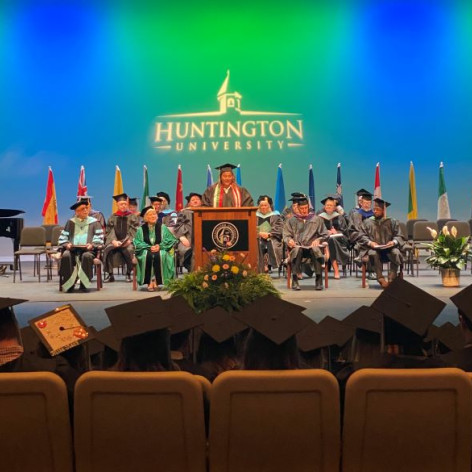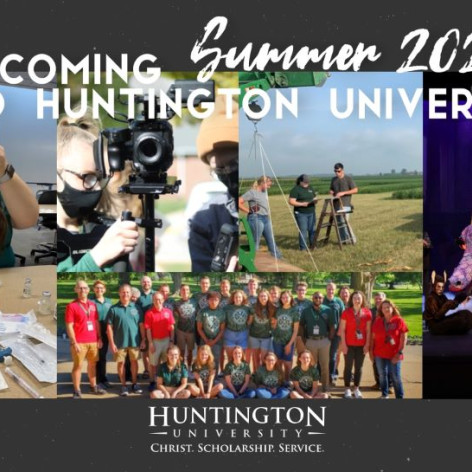Education majors host Northwest students at Thornhill
FOR RELEASE: Thursday, September 18, 2008
Huntington, Ind.-When the kindergarten classes from Northwest Elementary visited the Thornhill Nature Preserve on Sept. 17, they brought with them curiosity and enthusiasm. And, when they brought it to Thornhill, they brought it to the right place. Located a few short miles from the Huntington University campus, the Thornhill Nature Preserve is a 77-acre treasure of Huntington University. Students can become a part of God's natural world at Thornhill by breathing in the scent of the pines, strolling the trails and observing the creatures around the ponds, fields and in the streams.
Carrie Hall demonstrates how to make a paper spider while teaching "The Eensie Weensie Spider" rhyme.
Thornhill has been a part of Huntington University since 1967. It was previously owned by a teacher named Mabel Thorne who wanted to keep alive her appreciation of God's natural beauty and her devotion to excellent teaching.
Today, Lisa Geller is the coordinator of events at Thornhill Nature Preserve. She works in the nature center which has a fireplace, library and a small kitchen in addition to a large classroom. The nature center is surrounded by mature trees and has expansive windows.
Geller advises the Huntington University students and works with them to develop teaching plans at Thornhill that implement the educational theories taught at Huntington. She functions as the liaison between Huntington University and the public schools that visit Thornhill. Geller is the administrator of the Education Department's sophomore practicum. One group of the Huntington University education students that are enrolled in the sophomore practicum meet every Wednesday morning at Thornhill. Here, they exchange ideas with Geller who strategizes and plans educational sessions with them.
Shay Jones plays limbo with Northwest Elementary students.
The education majors at Huntington University study various methods of presenting material to students. Traditional teaching methods rely on one teacher per classroom. But, there is a growing trend today toward co-teaching. There are about six ways of approaching co-teaching. First, there is a method known as the one teacher, one observer approach where one instructor teaches and a second teacher takes notes.
Second, there is parallel teaching which is also taught by two teachers. Each teacher instructs one half of the class. A third type is alternative teaching in which one teacher instructs most of the class while another teacher works with a small group. A fourth style is one teacher, on assist. In this method, one teacher teaches the entire class while another teacher quietly assists students. A fifth style is the teaming approach. In this method, two teachers share duties equally in the class.
Brooke Theole plays a nursery rhyme game with students from Northwest Elementary.
The sixth approach is station teaching. Usually station teaching is divided into two parts with each instructor teaching at one station while the groups of students rotate from station to station. This concept of station teaching is the method that Huntington University students practiced at Thornhill. They organized a two-hour learning event for the Northwest Elementary kindergartners. The students planned, prepared and rehearsed ahead of time what would take place at their station. First, the Huntington University students decided the concepts and themes that would be taught. Next, they assembled and cut out all of the materials, papers and craft objects needed for each station. Then, they went through a rehearsal and role-playing activity to be on guard for the unexpected.
Alex Lute, a junior special education and elementary education major was concerned about keeping the program moving. "With 50 children and eight learning stations, we have much to accomplish within a two-hour time frame."
Lisa Geller discusses teaching plans with Alex Lute.
Lute is from Dyer, Ind., and has a working knowledge of sign language. He plans to one day teach hearing impaired children and also is interested in theatre. On the day that Northwest Elementary visited, Lute led groups of school children through an outdoor hunt that taught the alphabet. The kindergartners scampered about in search of paper lambs that were labeled with alphabet letters. When their hunting was completed, they clutched their prized lambs and brought them to Lute to play a game of identification.
Alicia Miller is a sophomore from Indianapolis, Ind., and she is majoring in special needs education and elementary education. She has worked with children before as a camp counselor and at her church. Miller was delighted to be working at Thornhill. "I love being outside. I collected insects when I was young. I'm very comfortable wit nature." At Thornhill, the learning station that Miller instructed taught kindergartners to recognize the difference between upper and lower case letters. This concept was presented by using the nursery rhyme scheme of the "The Three Little Kittens." The boys and girls listened to Miller read aloud to them and later played an alphabet game with paper mittens.
Alicia Miller reads "The Three Little Kittens" to students from Northwest Elementary.
Jeannette Shively, a sophomore from Columbus, Ohio, looks forward to a career of working with middle school and high school students. "I feel like I can relate better to older kids. I like to encourage them." She also has worked with children extensively through her church. At Thornhill, Shively led children through an art project based on "Hickory Dickory Dock" theme. This project reinforced time telling skills. At this learning station, the children practiced craft making skills and learned to tell time.
Jenna Thurston is a junior from Van Wert, Ohio, and is majoring in art education. She feels that teaching at Thornhill shows the kindergartners that the whole world is a classroom. Thurston hopes to help students understand godly values by "respecting the children, having a positive attitude, being patient and teachings kids to share." While at Thornhill, Thurston guided children through an outdoor counting game based on the "Old Mother Hubbard" nursery rhyme. The kindergartners used actual dog biscuits as the counting objects in the game.
Casey Koester cuts out materials in preparation for the Thornhill visit.
Brooke Theole is a sophomore elementary education major from Effingham, Ill. She feels that her education classes at Huntington University have prepared her well for her experiences at Thornhill. Theole also thinks that her Thornhill experience will improve her relations with fellow Huntington University students on campus. "I believe that serving at Thornhill makes you think outside of the box." Theole used the theme of "Humpty Dumpty" as a vehicle to teach rhyming to the kindergarten students. Of course, no Humpty Dumpty game would be complete without eggs and the children engaged in hand-on activities with plastic eggs.
Shay Jones is a sophomore pursuing a double major of elementary education and special education. Jones' calling to study special education is deep because she grew up with a sister that has autism. Shay has firsthand knowledge of living with the challenges of a special needs child. Jones recommends Thornhill as a great place for anyone to learn. "I hope when the kindergartners leave Thornhill, that they will remember this as a good learning experience. I think that they will leave happier than when they arrived here." While at Thornhill, Jones played the limbo with the kindergartners using the rhyme of "Jack Be Nimble."
Carrie Hall, a sophomore elementary education from Pandora, Ohio, thought that the experience of serving at Thornhill would eventually make her a better teacher. She believes that getting to understand the behavior of children by their age group will prepare her for her future career. "I try to remember what I was like as a kindergartner. I think that I was kind of hyper." At Thornhill, she taught at a learning station that was based on the "Eensy Weensy Spider" nursery rhyme. Hall's kindergartners carefully assembled paper spiders and practiced counting. Many of the children wanted to use their spider as a Halloween decoration at home.
Casey Koester is a sophomore elementary education and graphic design major from Huntington, Ind. She looks forward to one day teaching young children. Her learning station revolved around the "Little Jack Horner" theme. Children went through the motions of pulling plums out of a pie in a game that taught alphabet letter recognition. "Kindergarten students are such a great age," Koester said. "They are full of wonder and enthusiasm. They give so much love and joy. Working with the kids really boosted my spirits."



